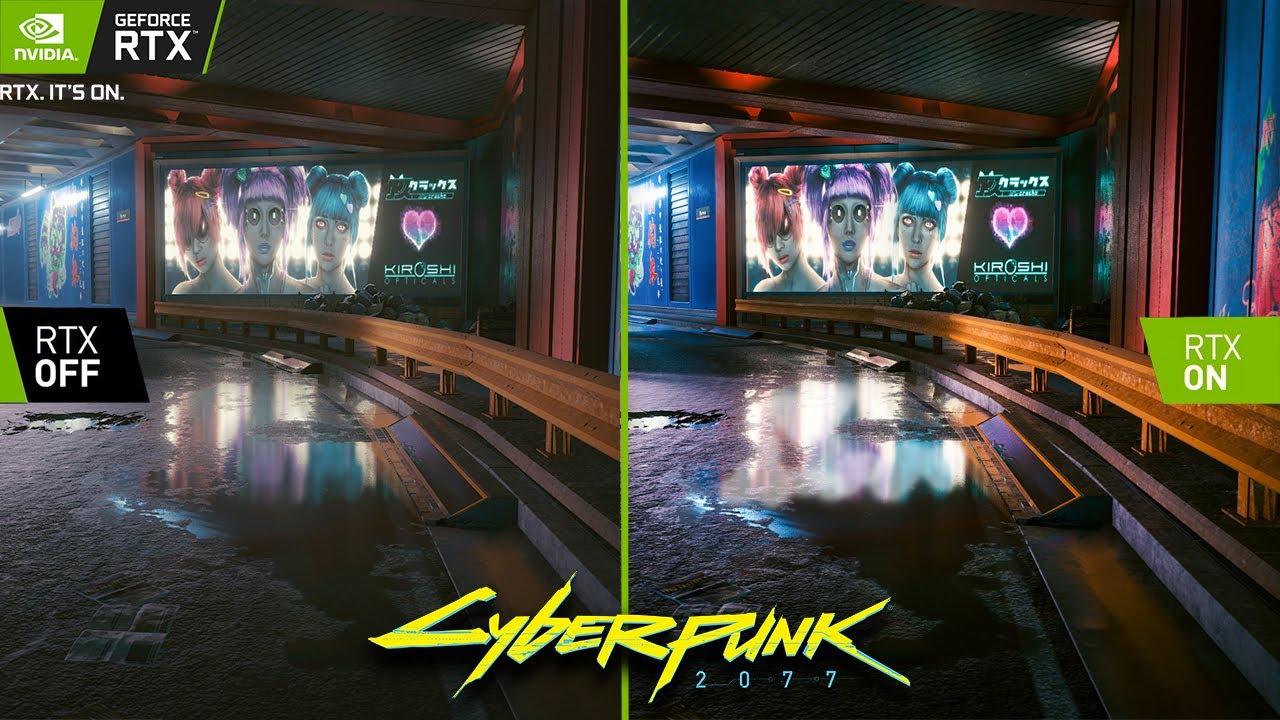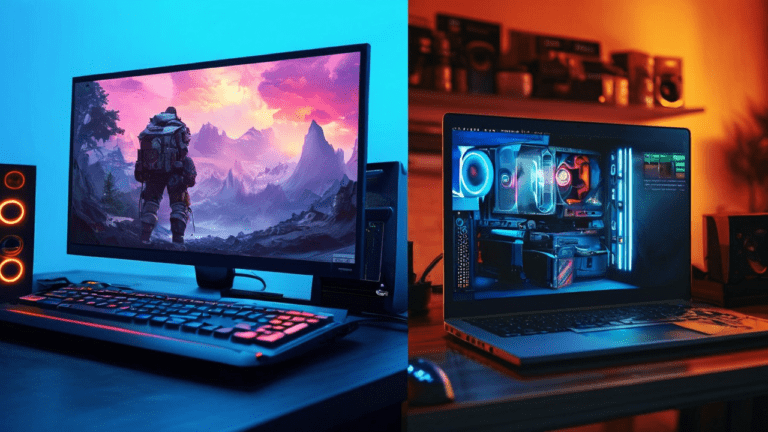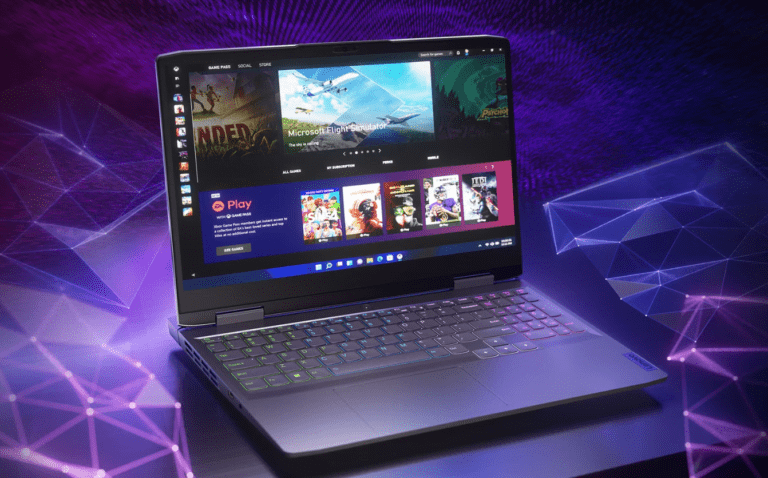In the ever-evolving landscape of gaming, technology continually pushes the boundaries of visual realism and immersive experiences. One such breakthrough that has left a lasting impact is the integration of ray tracing in gaming laptops. Now we will take a deep dive into the intricacies of ray tracing, tracing its roots from its conceptualization to its present-day significance in shaping the gaming industry.
What is Ray Tracing?

At its core, ray tracing is a rendering technique that simulates the behavior of light in a virtual environment. Unlike traditional rasterization, which approximates lighting effects, ray tracing meticulously traces the path of individual rays of light, accurately replicating the way light interacts with virtual surfaces. This level of precision enables the generation of photorealistic graphics, bringing virtual worlds to life with unparalleled visual fidelity.
Evolution of Graphics in Gaming Laptops
The journey of graphics in gaming laptops has been marked by continuous innovation. From the pixelated landscapes of early games to the advent of three-dimensional graphics, the evolution has been relentless. The integration of dedicated graphics processing units (GPUs) and advancements in hardware paved the way for more detailed and vibrant visuals. Ray tracing represents the next leap, introducing a level of realism previously unimaginable on portable gaming devices.
Significance of Ray Tracing in Gaming
Ray tracing isn’t merely a cosmetic enhancement; it fundamentally transforms the gaming experience. By simulating the physics of light, it introduces dynamic lighting, accurate reflections, and realistic shadows. This not only enhances the visual appeal but also fosters a deeper sense of immersion and presence within the gaming environment. As game developers harness the power of ray tracing, it becomes a catalyst for a new era of visually stunning and emotionally engaging gaming experiences.
Basics of Ray Tracing

Ray tracing operates on the principle of simulating the behavior of light rays in a virtual environment. The process can be broken down into several key steps:
- Ray Generation: The scene is viewed from a virtual camera, and rays are cast from the camera into the scene. Each ray represents a potential path that light could take.
- Intersection Testing: The rays are traced through the virtual scene, and intersections with virtual objects are determined. This involves checking whether a ray intersects with any objects in the 3D space.
- Light Interaction: Once an intersection is found, the ray continues to simulate the behavior of light. It can be refracted, reflected, or absorbed based on the properties of the materials in the scene.
- Shadow Rays: To determine if a point is in shadow, additional rays are cast from the point of intersection towards the light sources. If these rays intersect with objects, the point is in shadow.
- Recursive Reflection and Refraction: For reflective and transparent surfaces, additional rays are traced recursively, simulating multiple bounces of light to create realistic reflections and transparency.
- Color Calculation: At each point of intersection, the color is calculated based on the lighting model, material properties, and the interaction with light sources.
The combination of these steps results in the creation of a detailed and realistic image, capturing intricate lighting effects and reflections.
Rendering Realistic Lighting and Reflections
Ray tracing excels at producing lifelike lighting effects, surpassing traditional rendering techniques. It accurately simulates the behavior of light sources, creating soft shadows, global illumination, and intricate interplay between light and shadow. This level of precision is particularly evident in reflections, where surfaces mirror their surroundings realistically, enhancing the overall visual quality of the scene.
Global Illumination
Ray tracing captures indirect lighting, allowing light to bounce off surfaces and contribute to the illumination of other objects in the scene. This results in a more natural and visually appealing lighting model.
Soft Shadows
Unlike the sharp shadows produced by traditional rendering, ray tracing generates soft shadows by considering the size and shape of the light source. This adds a level of subtlety and realism to the lighting in the virtual environment.
Accurate Reflections
Ray tracing accurately depicts reflections on surfaces, whether it’s a shiny floor reflecting a character or a water surface mirroring the surrounding scenery. This reflective realism significantly contributes to the immersive nature of the gaming experience.
Impact on Visual Realism in Games
The adoption of ray tracing in games has a profound impact on visual realism, elevating graphics to unprecedented levels. This impact can be observed in several key areas:
Ray tracing captures intricate details of virtual environments, from the subtle play of light on surfaces to the reflections in glossy materials, resulting in a level of detail that was previously unattainable.
Realistic lighting and reflections create a more immersive gaming environment, allowing players to feel a deeper connection to the virtual worlds they explore.
The culmination of accurate lighting, reflections, and shadows contributes to the creation of photorealistic scenes. Ray tracing enables game developers to approach cinematic quality in real-time graphics.
Gaming Laptops with Ray Tracing
The integration of ray tracing technology into gaming laptops has transformed the portable gaming landscape, bringing unprecedented visual fidelity to on-the-go enthusiasts. Leading brands such as ASUS, MSI, Acer, and more have embraced this revolutionary feature in their flagship models, making ray tracing accessible beyond traditional desktop setups. The gaming laptops with ray tracing capabilities cater to a diverse audience, offering a range of form factors from sleek ultrabooks to robust gaming powerhouses, ensuring that users can find a device that aligns with their gaming preferences and lifestyle.
GPU Architectures
At the heart of the ray tracing revolution in gaming laptops lies advanced GPU architectures, with NVIDIA’s RTX series taking the lead. These GPUs are equipped with dedicated RT cores, specifically designed to accelerate real-time ray tracing. The combination of CUDA cores, RT cores, and Tensor cores enables these GPUs to deliver not only stunning ray-traced visuals but also exceptional overall gaming performance. Understanding the GPU architecture is crucial for enthusiasts looking to harness the full potential of ray tracing on their gaming laptops.
Form Factors and Designs
Gaming laptops with ray tracing capabilities come in various form factors and designs, accommodating different user preferences and needs. From slim and portable ultrabooks suitable for on-the-go gaming to larger, more powerful designs with enhanced cooling solutions for extended gaming sessions, users can choose a laptop that fits their lifestyle. The diversity in designs reflects the industry’s commitment to providing a tailored gaming experience for every type of user, ensuring that both aesthetics and functionality are considered.
Key Features and Specifications
The cornerstone of a gaming laptop’s ray tracing capabilities lies in its GPU specifications. Examining the number of CUDA cores, RT cores, and Tensor cores provides insights into the GPU’s raw power and its ability to handle ray tracing workloads efficiently. Understanding these specifications empowers users to make informed decisions based on the performance they expect in ray-traced games and other graphics-intensive applications.
Display Technology
The display technology of gaming laptops plays a pivotal role in enhancing the overall gaming experience, especially when it comes to ray tracing. High refresh rates, low response times, and high resolutions contribute to smoother and more immersive gameplay. Exploring how these features complement the ray tracing experience helps users appreciate the importance of a high-quality display in maximizing the visual impact of ray-traced graphics.
Thermal Solutions
Effectively managing heat is crucial for gaming laptops, particularly those equipped with ray tracing-capable GPUs. Robust thermal solutions, including advanced cooling mechanisms and efficient heat dissipation, ensure that the laptop can maintain peak performance during extended gaming sessions. Examining the thermal solutions offered by gaming laptops provides insights into their ability to handle the demands of ray tracing without compromising stability.
Storage Options
In the realm of modern gaming, storage is a critical component that influences not only game load times but also the overall responsiveness of the system. Gaming laptops with ray tracing capabilities often leverage high-speed SSDs to enhance the gaming experience. Exploring storage options, including capacity and speed, helps users assess the laptop’s ability to handle large game files and deliver a seamless gaming experience.
Challenges and Criticisms
It’s not all great news for Ray Tracing as it has also faced a lot of challenges and criticism from the community as well. Let’s take a detailed look into it:
1. Battery Life
One of the primary challenges associated with gaming laptops, particularly those with ray tracing capabilities, is the impact on battery life. The demanding nature of real-time ray tracing workloads, combined with the power-hungry nature of dedicated GPUs, can significantly reduce the laptop’s battery endurance. Users may need to balance performance expectations with the need for extended gaming sessions on the go.
2. Heat Management
Intensive graphical processes, such as ray tracing, generate substantial heat within the laptop. Efficient heat management becomes critical to prevent thermal throttling and maintain optimal performance. Gaming laptops with advanced cooling solutions, including multiple fans and heat pipes, aim to address this challenge, but it remains an ongoing concern for manufacturers and users alike.
3. Pricing Considerations
The integration of dedicated ray tracing hardware adds to the overall cost of gaming laptops. GPUs with specialized cores for ray tracing are typically more expensive, contributing to higher laptop prices. This pricing consideration may pose a challenge for budget-conscious gamers seeking the latest in graphical technology without breaking the bank.
Balancing affordability with performance expectations is a delicate task for consumers. While ray tracing undoubtedly enhances visual experiences, users must weigh the value of these advanced features against their budget constraints. Striking the right balance between price and performance becomes a key consideration when investing in a gaming laptop with ray tracing capabilities.
4. Compatibility Issues and Software Optimization
Not all game developers integrate ray tracing into their titles, and implementing this technology can be resource-intensive. As a result, users may face compatibility issues, limiting the number of games that fully leverage ray tracing capabilities. The evolving nature of game development and varying degrees of support for ray tracing across titles contribute to this challenge.
Effective utilization of ray tracing technology relies heavily on software optimization and consistent driver support. Users may encounter issues if game developers and hardware manufacturers do not provide timely updates and patches. The interplay between game engines, GPU drivers, and the inherent complexity of ray tracing implementation can lead to compatibility challenges, affecting the overall user experience.
Frequently Asked Questions (FAQs):
What is ray tracing, and how does it enhance gaming on laptops?
Ray tracing is a rendering technique that simulates the behavior of light in a virtual environment. In gaming laptops, it enhances visual realism by accurately depicting lighting effects, shadows, and reflections, resulting in a more immersive and lifelike gaming experience.
Which gaming laptop brands offer ray tracing capabilities?
Several leading brands, including ASUS, MSI, and Acer, offer gaming laptops with ray tracing capabilities. These laptops often feature NVIDIA’s RTX series GPUs, known for their dedicated RT cores designed to accelerate real-time ray tracing.
How does ray tracing impact gaming performance on laptops?
While ray tracing enhances visual realism, it can also impact gaming performance, particularly frame rates. The extent of the impact depends on the specific game, the complexity of ray tracing effects, and the overall hardware specifications of the laptop.
Are gaming laptops with ray tracing suitable for professional workloads?
Gaming laptops with ray tracing capabilities, often equipped with powerful GPUs, can be suitable for certain professional workloads such as content creation and 3D modeling. However, dedicated workstations may be more suitable for intensive professional tasks.
Do all games support ray tracing on gaming laptops?
Not all games support ray tracing, as it requires specific development efforts from game developers. However, an increasing number of AAA titles are incorporating ray tracing effects, providing users with a growing library of games that leverage this technology.
Conclusion
The integration of ray tracing technology into gaming laptops represents a paradigm shift in portable gaming. The convergence of advanced GPU architectures, diverse form factors, and cutting-edge display technologies has ushered in an era where users can experience unparalleled visual fidelity and realism on the go. As the industry continues to push the boundaries of what is possible, gaming laptops with ray tracing capabilities stand as a testament to the relentless pursuit of immersive gaming experiences.




